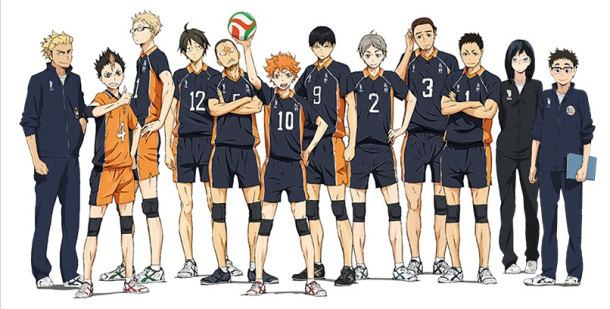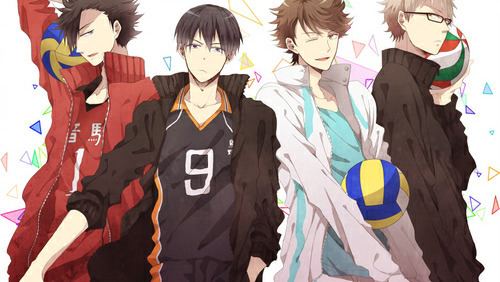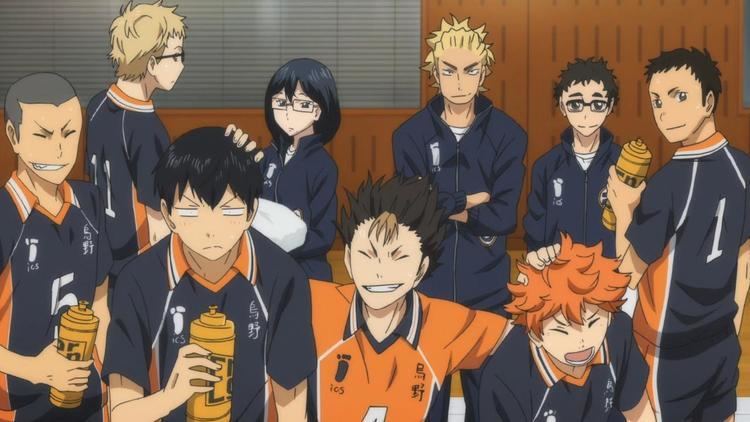Written by Haruichi Furudate English publisher Viz Media Imprint Jump Comics Studio Production I.G Magazine Weekly Shōnen Jump | Published by Shueisha Demographic Shōnen Genre Sports (Volleyball) Music by Yûki Hayashi Publishers Viz Media (NA), Shueisha | |
 | ||
Original run February 20, 2012 – present Similar Kuroko's Basketball, Gin Tama, Attack on Titan, My Hero Academia, Bungo Stray Dogs | ||
Haikyū!! (ハイキュー!!) is a Japanese shōnen manga series written and illustrated by Haruichi Furudate and a sequel. Attacker You! Individual chapters have been serialized in Weekly Shōnen Jump since February 2012, with bound volumes published by Shueisha. The series was initially published as a one-shot in Shueisha's seasonal Jump NEXT! magazine prior to serialization. As of December 2016, twenty-four volumes have been released in Japan. The manga has been licensed in North America by Viz Media.
Contents

An anime television series adaptation by Production I.G aired from April 2014 to September 2014, which has been licensed for digital and home release in North America by Sentai Filmworks. The second season of the anime aired from October 2015 to March 2016. A third season aired from October 2016 to December 2016.

Plot

Junior high school student Shōyō Hinata gains a sudden love of volleyball after seeing a national championship match on TV. Although short in height, he becomes determined to follow in the footsteps of the championship's star player, nicknamed the "Little Giant", after seeing his plays. He creates a volleyball club and begins practicing by himself. Eventually 3 other members join the team by his last year of middle school, pushing Hinata to persuade his two friends who are in different clubs to join just for the tournament. However, they are defeated in their first tournament game after being challenged by the championship favorite team, which includes the so-called "King of the Court" Tobio Kageyama, in the first round. Though Hinata's team suffers a miserable defeat, he vows to eventually surpass Kageyama and defeat him. Fast-forward to highschool, Hinata enters Karasuno Highschool with the hopes of joining their volleyball club. Unfortunately for him, the very person he swore to surpass appears before him as one of his new teammates. At first Hinata and Kageyama are unable to work together, causing the team captain to kick them out of the club. The two decide to challenge the elder members of the team to a match, hoping that if they win they will prove they can work together and be allowed to rejoin. The team captain accepts the challenge, and working with another member of the team, Hinata and Kageyama win the match and are let back into the club. By combining the genius-like qualities of Kageyama with Hinata's sheer athleticism, the duo create an invincible brand-new volleyball tactic. Their new combo allows them to get over their differences and creates a strange alliance between the two filled with fun and laughter for them and their teammates. Thus begins the Karasuno boys' volleyball team's journey to the top.
Manga
Written and illustrated by Haruichi Furudate, the series has been serialized in Weekly Shōnen Jump since February 2012. As of December 2014, the series has sold over twelve million volumes. At their panel at New York Comic Con, North American publisher Viz Media announced their license of the manga and released the series in 2016.
Radio drama
A radio drama for the series was broadcast in November 2012 on TV Tokyo's Sakiyomi Jum-Bang! program, with multiple voice actors providing voice samples for the characters. It was later distributed in December 2012 via Shueisha's Vomic website.
Anime
A television anime series produced by Production I.G premiered on April 6, 2014 on MBS, other JNN stations, and with English subtitles on Crunchyroll. From episodes 1-13, the opening theme song is "Imagination" by Spyair, while the ending theme song is "Tenchi Gaeshi" by Nico Touches the Walls. From episode 14-25, the opening is "Ah Yeah" by Sukima Switch, and the ending is "LEO" by Tacica. "Ah Yeah" is also used as the ending for episode 14, which has no opening. The anime has been licensed for digital and home video release by Sentai Filmworks.
A second season premiered on October 4, 2015. From episodes 1-13, the opening theme song is "I'm a Believer" by Spyair, while the second ending theme song is "Climber" by Galileo Galilei. From episodes 14-25, the opening theme song is "FLY HIGH" by Burnout Syndromes, while the ending theme song is "Hatsunetsu (Fever)" (発熱 - はつねつ) by Tacica.
A third season, titled Haikyū!! Karasuno High School vs Shiratorizawa Academy (ハイキュー!! 烏野高校 VS 白鳥沢学園高校, Haikyū!! Karasuno Kōkō VS Shiratorizawa Gakuen Kōkō), premiered on October 8, 2016. The opening theme song is "Hikariare" by Burnout Syndromes, while the ending theme song is "Mashi Mashi" by Nico Touches the Walls. Sentai Filmworks has also licensed the third season.
Video games
Shoyo appears as a support character in the Jump crossover fighting game J-Stars Victory VS for PlayStation 3, PlayStation 4 and PlayStation Vita.
Reception
The series has been met with generally positive reception. As of May 2013, over two million volumes have been sold. The first volume was ranked 22nd on the Tohan charts between June 4 and 10, 2012. The second volume was ranked 18th on the charts between August 6 and 12, 2012, and the third volume was also ranked 18th between October 8 and 14, 2012. Additionally, the series was ranked 4th out of a total of fifteen comics recommended in Honya Club's Zenkoku Shoten'in ga Eranda Osusume Comic 2013 ranking.
In 2016, the manga won in the Shōnen category at the 61st Shogakukan Manga Awards.
